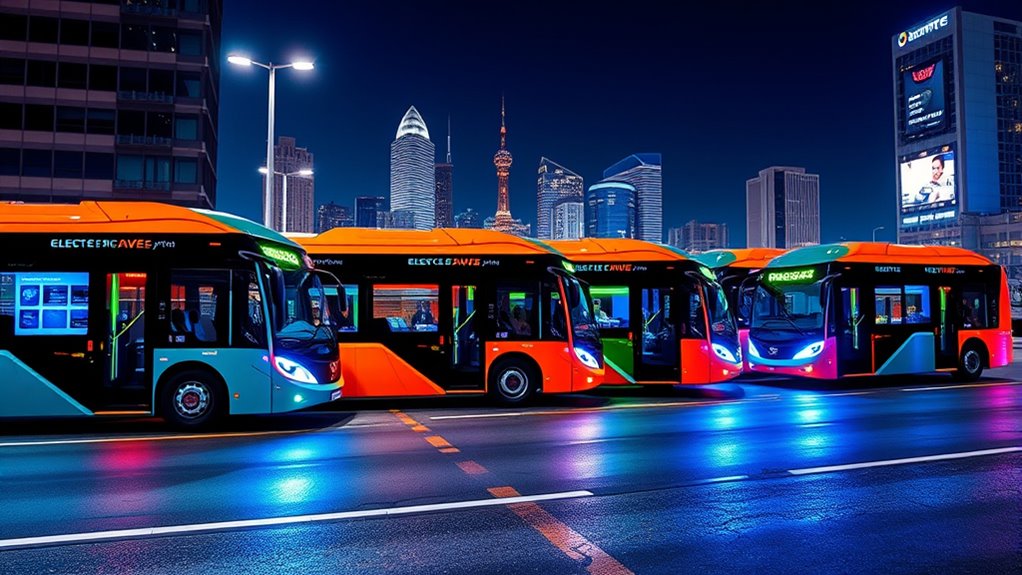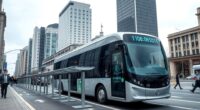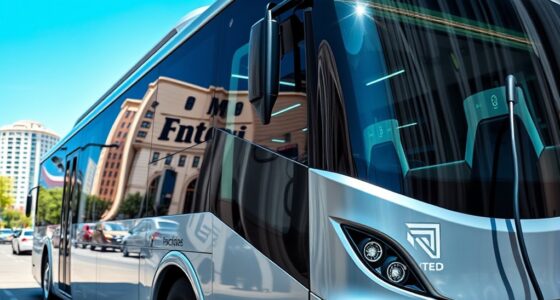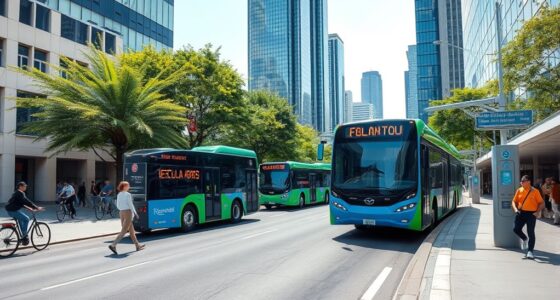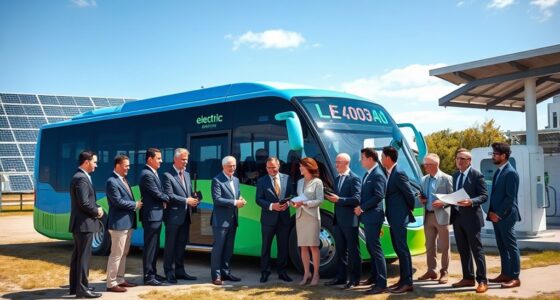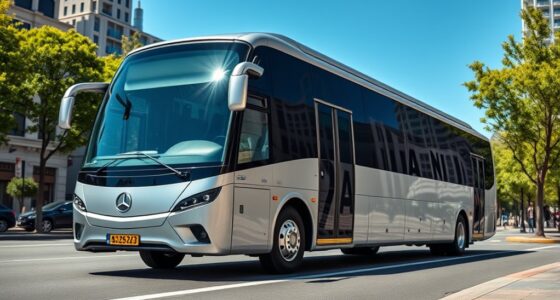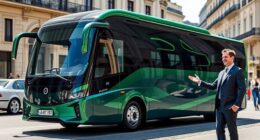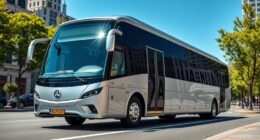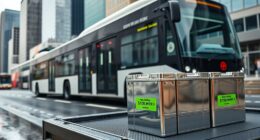In 2025, the top electric bus models include BYD’s advanced, high-range buses with fast charging, and Volvo’s efficient, safety-focused designs that prioritize sustainability. Volkswagen’s ID. Buzz offers sleek, eco-friendly urban transit, while the VDL Citea LF-122 features modular systems for easy maintenance. Proterra leads with innovative batteries supporting longer routes and quicker charging. Stick around to discover what makes these models stand out and how they’re shaping modern city transit.
Key Takeaways
- The BYD Electric Bus continues to lead with new models featuring higher capacity batteries and faster charging technology launched in 2025.
- Volvo introduced the latest electric bus series emphasizing safety, efficiency, and smart route management solutions in 2025.
- Volkswagen unveiled the redesigned ID. Buzz electric bus, blending sustainable materials with rapid charging capabilities in 2025.
- VDL Citea LF-122 received updates for enhanced energy efficiency and modular design, debuting new variants in 2025.
- Proterra launched advanced electric bus models with improved range, faster charging, and smart technology integration in 2025.
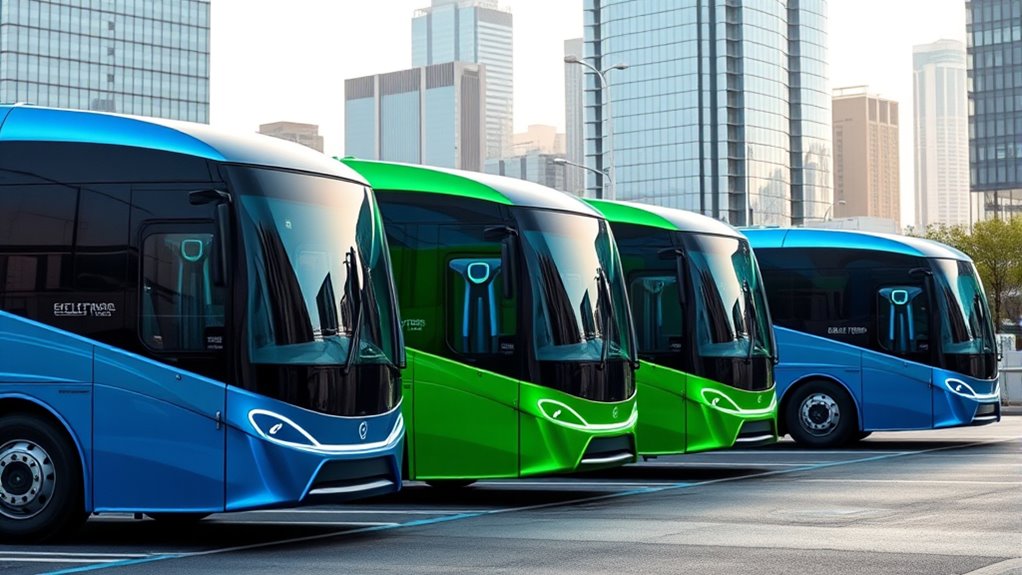
As we look ahead to 2025, electric buses are transforming transportation with cutting-edge technology and sustainable design. These models aren’t only more environmentally friendly but also packed with innovations that improve performance, efficiency, and passenger comfort.
Among the top contenders, the BYD Electric Bus continues to dominate the global market, offering a range of advanced models that leverage the latest battery and drive technologies. Known for its reliability and extensive production capabilities, BYD’s electric buses feature high-capacity batteries that deliver impressive range and fast charging, making them suitable for urban routes with demanding schedules.
BYD Electric Buses lead the market with advanced batteries, fast charging, and proven reliability for demanding urban routes.
Volvo remains a key player in the electric bus industry, delivering solutions that emphasize safety, efficiency, and sustainability. Their latest electric models incorporate modular drive systems, allowing for flexible configurations suited to various fleet sizes and operational needs.
Volvo’s focus on energy optimization and durable design guarantees that their buses reduce emissions while maintaining high performance during long service hours. The company’s commitment to integrating smart technology enhances route management and passenger experience, positioning Volvo as a leader in the shift toward cleaner public transportation.
Volkswagen’s ID. Buzz stands out as a futuristic electric bus, blending innovative design with sustainable technology. It incorporates advanced batteries that extend range and support rapid charging, vital for urban transit systems aiming for minimal downtime.
The ID. Buzz’s emphasis on eco-friendly materials and modular construction aligns with the broader market trend toward sustainable design, making it an appealing choice for cities aiming to cut their carbon footprint. Its sleek, modern aesthetic also appeals to passengers seeking a comfortable and forward-thinking transit experience.
VDL’s Citea LF-122 is making waves in 2025, especially after its inclusion in the Ebus Test 2025. This model exemplifies VDL’s commitment to efficiency and adaptability, featuring modular drive approaches that improve maintenance and customization.
Its advanced energy consumption systems optimize range and operational costs, which is vital for fleet operators looking to maximize ROI. The Citea LF-122’s focus on sustainability, coupled with rapid charging capabilities, makes it a practical and eco-conscious choice for urban transit authorities.
Proterra’s electric buses continue to lead in the U.S., pushing the envelope with innovative battery technology that enhances range and reduces charging times. Known for their focus on energy efficiency, Proterra’s latest models incorporate smart technology and sustainable materials, aligning with the industry’s push toward greener transportation. A recent trend is the increasing integration of family background insights into design and branding, reflecting the importance of personal stories in market appeal.
These buses are designed to support large-scale deployments, helping cities meet aggressive emission reduction goals while providing reliable, cost-effective transit options.
Frequently Asked Questions
What Is the Charging Time for Each Model?
You’re curious about charging times for these buses. The VW ID. Buzz can reach 80% in under 30 minutes with DC fast charging.
The MAN Lion’s City 12 E is designed for long routes, implying efficient charging, though specifics aren’t detailed.
The BYD Electric Bus, with solid-state batteries, likely charges faster.
The Volvo LUMINUS and Solaris Urbino 10.5 Electric probably use standard fast-charging systems, with exact times depending on infrastructure.
Are These Buses Suitable for Long-Distance Routes?
You wonder if these buses suit long-distance routes. The Proterra ZX5, with its 240-mile range and fast charging, works well for intercity travel.
BYD models, with their long-range options, are also suitable but need compatible infrastructure.
However, the ADL Enviro400EV, Mercedes eCitaro, and Volvo buses mainly excel in urban or suburban settings due to limited range and charging capabilities.
What Safety Features Are Included in These Models?
Imagine stepping onto a bus where safety feels woven into every detail. You’ll find collision prevention systems like Automatic Emergency Braking with pedestrian detection, adaptive cruise control, and active blind spot monitoring.
Battery safety is prioritized with enclosed, cooled packs, automatic disconnects, and rollover protection.
Inside, airbags and occupant protection systems shield you, while driver-assist tech like real-time diagnostics and over-the-air updates keep you secure, confident, and in control throughout your journey.
How Do Operating Costs Compare to Diesel Buses?
You’ll find that electric buses have considerably lower operating costs than diesel ones. Electricity costs about 2.5 times less per mile, making fueling cheaper and more predictable.
Plus, electric buses need less maintenance due to fewer moving parts, saving you money on repairs and labor. Over their lifetime, these savings can add up to over $100,000, offsetting the higher initial investment and providing long-term economic benefits.
Are There Government Incentives for Purchasing These Buses?
You’ll find many government incentives available for purchasing electric buses. Programs like the EPA Clean School Bus Program and the National Electric Vehicle Infrastructure Program offer substantial funding and infrastructure support.
Tax credits, such as the Qualified Commercial Clean Vehicle Credit, provide up to $40,000 per bus.
Local subsidies and long-term support also make electric buses more affordable, helping you reduce costs and promote cleaner, more sustainable transportation options.
Conclusion
So, after exploring these top 5 electric bus models of 2025, it’s clear that the future of transportation is electric—and surprisingly stylish. Who would’ve thought that buses could become the coolest kids on the block? As you consider your next ride, remember: in a world rushing toward sustainability, these buses show that we’re finally heading in the right direction. Ironically, the only thing left to do is sit back, enjoy the ride, and watch the planet thank us.
